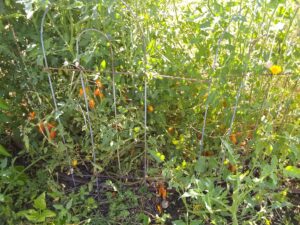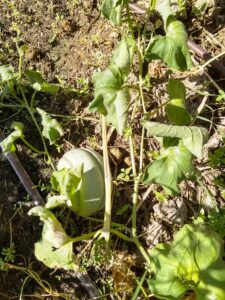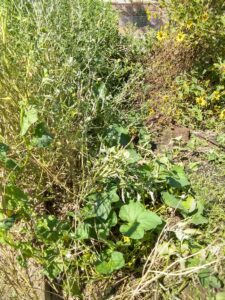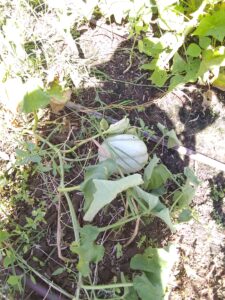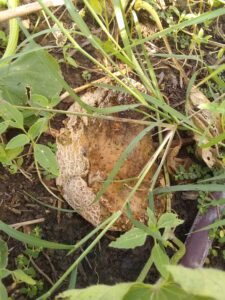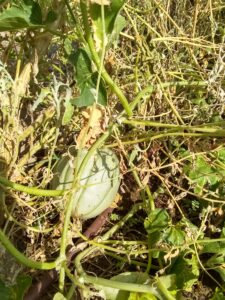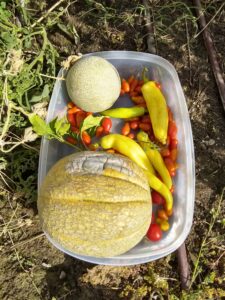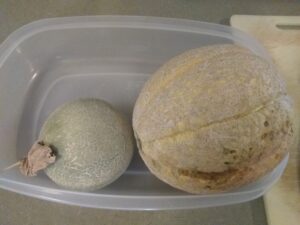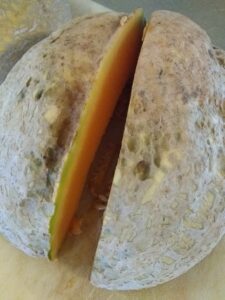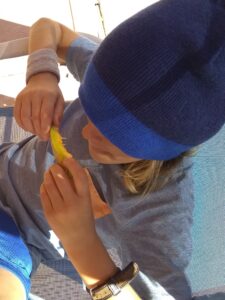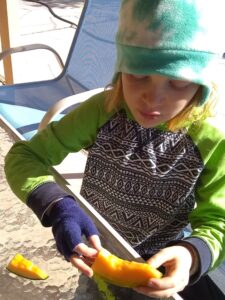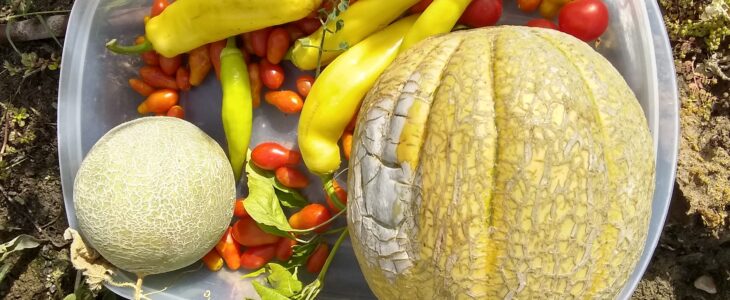
The melon’s parents grew on a commercial farm, likely in Yuma. It was delivered to Basha’s or Albertson’s, then consumed by my family, sometime in 2020. Our family dubbed this variety “Grocery Store Cantaloupe”.
The melon’s parents grew in a Native Seeds/SEARCH field somewhere in the Desert Southwest, “A Spanish heirloom from northern New Mexico” according to the seed catalogue. “Chimayo” is its name.
The seeds were discarded into my backyard compost, where they did not actually rot like the rind and instead lay in waiting.
The seeds came in a packet I purchased in April 2021.
On a bright spring day in 2021, I taught a composting lesson in the Marana Community Garden. Students observed store-bought compost (already spread in garden rows), homemade compost (transported in a tub), and the stars of that day: worms and their vermicompost (in a portable worm bin). The worms came back home with me. The tub of compost I unceremoniously dumped at the edge of the garden, to be spread another day.
Summer 2021 was coming soon. By the local weather, late spring is “foresummer” in the Sonoran Desert, that hot dry period with no realistic hope of rain. Seeds can go in, but earlier is better to gain some strength by June. My spring Garden Together series in the Marana Community Garden had been sweet but small, leaving me more labor to finish: adding compost and starting warm-season seeds despite the odds against them. Poke. Poke. Poke. In went the Chimayo melon seeds, plus rattlesnake beans and a mix of sunflowers. The latter two are reliable for me in many conditions. The melons were more in the “Let’s give it a try” category.
A mystery melon plant grew! Throughout the summer, the vine spread into the garden. So did many weeds. I accidentally yanked out a young, forming melon in my zeal to thin out the golden crownbeard and bermudagrass. I slowed down. And I remained curious if this melon plant was from the seed packet – since it actually looked a lot like the grocery store cantaloupe plants planted on purpose at home.
A large, twining melon plant grew. It came up later than mystery melon #1, but produced a ripe fruit by August. It rested heavily on the muddy ground, concealed by large, sheltering leaves. “I’ll pick it next time,” I thought, and continued pulling weeds from along the fence. Oops! Next time was too late. In September, the first fully formed melon of the season was a flat, largely decomposed skin. But wait – a second melon had developed in the meantime! Kid 1 and I examined it for a bit while exploring plot 37. There were stripes that set it apart from cantaloupe we had known, but only the beginning of “netting”. I decided to risk another “next time”.
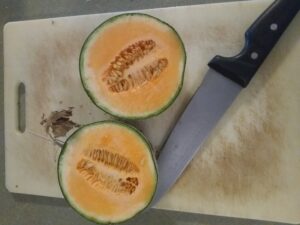 October 2021: Another actual melon appeared, with brainy bumps though still quite green, hanging without blemish from the garden fence! Now that I had a fruit by the opposite fence with which to compare, I could confidently call this mystery melon a grocery store cantaloupe – which means it planted itself from my home-made compost. Likewise, the heartily-producing pear tomato plants on the same side grew from compost into which over-ripe fruits in my backyard had dropped many months prior. I decided to take this prize produce home for a taste test.
October 2021: Another actual melon appeared, with brainy bumps though still quite green, hanging without blemish from the garden fence! Now that I had a fruit by the opposite fence with which to compare, I could confidently call this mystery melon a grocery store cantaloupe – which means it planted itself from my home-made compost. Likewise, the heartily-producing pear tomato plants on the same side grew from compost into which over-ripe fruits in my backyard had dropped many months prior. I decided to take this prize produce home for a taste test.
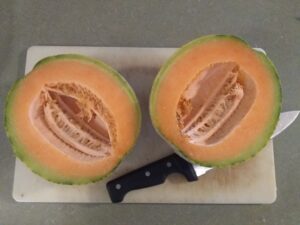 October 2021: This was one tough fruit. It survived the wait, but just barely – the side resting on the ground crawled with pill bugs tunneling into the remarkably thick skin. Neither isopods nor the scabby sunburn on the opposite side reached the pulp inside. The stripes were now prominent, and the netting nice and rough. I decided to take this prize produce home for a taste test.
October 2021: This was one tough fruit. It survived the wait, but just barely – the side resting on the ground crawled with pill bugs tunneling into the remarkably thick skin. Neither isopods nor the scabby sunburn on the opposite side reached the pulp inside. The stripes were now prominent, and the netting nice and rough. I decided to take this prize produce home for a taste test.
My two boys and I set up a semi-scientific test of even slices and sips of water in between tastes – though unfairly the grocery store melon had not been growing as long prior to picking than the chimayo melon. The results:
The grocery store melon was fibrous and bland, evoking a resounding “eh”. “It tastes like stale chocolate” offered Kid 2 kindly. I believe the little fruit could have inspired more delight if I let it grow larger and squishier. To not let the 6-month production efforts go to waste, I transformed the pulp into a banana-melon-milk smoothie that the kids gamely tried but let me finish. The seeds went into compost – how will the story go in a year or two?
The chimayo melon was juicy and sweet. “This is the BEST” both boys agreed. They continued to snack on the winner, and I continued to feed the family the gotta-eat-it-before-it-goes-bad slices for breakfast and lunch the following day. It was a big 6-month success that still brings a smile and sticky memories to my face. I saved the seeds and will definitely try growing more next summer for a sweet fall harvest.
